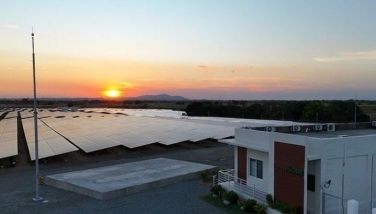Blackout hits Luzon
April 8, 2001 | 12:00am
Millions of people were roused from sleep by stifling heat early yesterday after an overloaded transmission line tripped and cut off electricity to Metro Manila and the rest of Luzon.
Officials of state-run National Power Corp. (Napocor) said electricity first went out at 3:30 a.m. following a technical fault at the 230-kilovolt plant in Tayabas, Quezon.
Traffic aides and police fanned out at dawn to coax hectic traffic through intersections jammed for lack of traffic lights, but their numbers were not enough to cope with the weekend vehicular volume, particularly in Manila.
International flights were delayed and local Websites crashed as the Napocor rushed to restore power. A second blackout, however, struck at past 10 a.m. Until 7 last night, some areas remained in darkness.
Napocor officials said the overload of the Tayabas line, which links power plants in the provinces of Quezon and Laguna, caused an automatic shutdown of all power stations linked to the Luzon grid as part of the system’s safety feature. Connectors linking the transmission line overheated and melted.
Yesterday’s blackout, at the start of a sweltering summer weekend, caused major discomfort to 35 million Filipinos looking forward to spending a relaxing Saturday.
Power was restored to about 60 percent of Luzon by 10:15 a.m. but the transmission system collapsed again after power supply from the Ilijan plant in Leyte was cut off.
Rolando Bacani, Napocor vice president for systems operations, said the converter of the Leyte-Luzon interconnection malfunctioned and caused it to trip, triggering a second system blackout.
"We are back to square one, meaning we are blacked out again," Bacani said.
That outage halted the Metro Rail Transit and Light Rail Transit systems in Metro Manila, causing further inconvenience to the riding public and causing more hellish gridlocks in the city streets.
Napocor was able to immediately restore power to areas covering Malacañang Palace, military and police installations, the international and domestic airports and water filtration plants. Residential areas were among the last to get back electricity which was restored to 72 percent at 5 p.m. and near-full capacity at around 7 p.m.
Napocor said repair efforts were hampered by the theft of aluminum high-voltage cables in a remote mountain area in Laguna near where the first outage occurred. Earlier this year, some 1,155 feet of aluminum cable about three inches in diameter was stolen, weakening a link in that area of the Luzon grid and preventing immediate diversion of electricity from power plants during yesterday’s blackout.
President Arroyo ruled out sabotage and assured the public that Napocor was doing the best it can to fix the problem.
"They cannot turn on everything immediately, but everything is being done to have total power back up in the Luzon grid within the day," the President said.
Napocor president Jesus Alcordo said the state firm would be implementing immediate changes in their maintenance schemes.
"We have agreed to inspect connectors more frequently – instead of once a year to every month, if necessary. We have the capability," Alcordo said.
Last October, a Luzon-wide power failure occurred after a transmission line fault.
Prior to that electricity lines tripped in December 1999 when jellyfish clogged a power plant reservoir in Sual, Pangasinan.
At least 12 outbound international flights, including those of flag carrier Philippine Airlines (PAL), were delayed for up to two hours at the Ninoy Aquino International Airport due to yesterday’s power outage.
Personnel at the airlines’ counters had to resort to a manual check-in of thousands of departing passengers. The same slow system was employed in the processing of travel documents at the immigration counters with the temporary unavailability of computer systems.
NAIA’s standby power was only sufficient for the lighting of the two terminals. Passengers had to sweat it out while waiting in long lines as the airconditioning was out.
Delayed were two departing flights of PAL, three of Northwest Airlines, two of China Airlines, two of Cathay Pacific, one of Egypt Air, one Japan Airlines and one of Pakistan Airlines.
However, 36 incoming international flights arrived on schedule and delays only took place at the arrival immigration counters. The encoding of disembarkation cards had been dispensed with until full power was restored.
Two domestic PAL flights – to Cotabato and Kalibo – were likewise delayed. Air Philippines, Asian Spirit and Cebu Pacific also missed flight departure times.
Airport general manager Edgardo Manda said NAIA’s generators are currently not enough to provide the required power for two international terminals during power outages.
Some of the available units, Manda noted, also conked out every now and then.
Meanwhile, the Laban ng Demokratikong Pilipino-Puwersa ng Masa (LDP-PnM) asked the country’s power utilities to ensure the uninterrupted power supply up to the close of the election period to ease fears of "an administration-sponsored plan to rig May polls."
LDP secretary general Agapito "Butz" Aquino said yesterday’s outage could have been part of a "dry run" for a fraud plan.
"There is basis to the worry of the voters that the massive power failure that hit Luzon was related to an administration plan," Aquino said in a statement. – With Rey Arquiza, Marichu Villanueva, Mike Frialde
Officials of state-run National Power Corp. (Napocor) said electricity first went out at 3:30 a.m. following a technical fault at the 230-kilovolt plant in Tayabas, Quezon.
Traffic aides and police fanned out at dawn to coax hectic traffic through intersections jammed for lack of traffic lights, but their numbers were not enough to cope with the weekend vehicular volume, particularly in Manila.
International flights were delayed and local Websites crashed as the Napocor rushed to restore power. A second blackout, however, struck at past 10 a.m. Until 7 last night, some areas remained in darkness.
Napocor officials said the overload of the Tayabas line, which links power plants in the provinces of Quezon and Laguna, caused an automatic shutdown of all power stations linked to the Luzon grid as part of the system’s safety feature. Connectors linking the transmission line overheated and melted.
Yesterday’s blackout, at the start of a sweltering summer weekend, caused major discomfort to 35 million Filipinos looking forward to spending a relaxing Saturday.
Power was restored to about 60 percent of Luzon by 10:15 a.m. but the transmission system collapsed again after power supply from the Ilijan plant in Leyte was cut off.
Rolando Bacani, Napocor vice president for systems operations, said the converter of the Leyte-Luzon interconnection malfunctioned and caused it to trip, triggering a second system blackout.
"We are back to square one, meaning we are blacked out again," Bacani said.
That outage halted the Metro Rail Transit and Light Rail Transit systems in Metro Manila, causing further inconvenience to the riding public and causing more hellish gridlocks in the city streets.
Napocor was able to immediately restore power to areas covering Malacañang Palace, military and police installations, the international and domestic airports and water filtration plants. Residential areas were among the last to get back electricity which was restored to 72 percent at 5 p.m. and near-full capacity at around 7 p.m.
Napocor said repair efforts were hampered by the theft of aluminum high-voltage cables in a remote mountain area in Laguna near where the first outage occurred. Earlier this year, some 1,155 feet of aluminum cable about three inches in diameter was stolen, weakening a link in that area of the Luzon grid and preventing immediate diversion of electricity from power plants during yesterday’s blackout.
President Arroyo ruled out sabotage and assured the public that Napocor was doing the best it can to fix the problem.
"They cannot turn on everything immediately, but everything is being done to have total power back up in the Luzon grid within the day," the President said.
Napocor president Jesus Alcordo said the state firm would be implementing immediate changes in their maintenance schemes.
"We have agreed to inspect connectors more frequently – instead of once a year to every month, if necessary. We have the capability," Alcordo said.
Last October, a Luzon-wide power failure occurred after a transmission line fault.
Prior to that electricity lines tripped in December 1999 when jellyfish clogged a power plant reservoir in Sual, Pangasinan.
Personnel at the airlines’ counters had to resort to a manual check-in of thousands of departing passengers. The same slow system was employed in the processing of travel documents at the immigration counters with the temporary unavailability of computer systems.
NAIA’s standby power was only sufficient for the lighting of the two terminals. Passengers had to sweat it out while waiting in long lines as the airconditioning was out.
Delayed were two departing flights of PAL, three of Northwest Airlines, two of China Airlines, two of Cathay Pacific, one of Egypt Air, one Japan Airlines and one of Pakistan Airlines.
However, 36 incoming international flights arrived on schedule and delays only took place at the arrival immigration counters. The encoding of disembarkation cards had been dispensed with until full power was restored.
Two domestic PAL flights – to Cotabato and Kalibo – were likewise delayed. Air Philippines, Asian Spirit and Cebu Pacific also missed flight departure times.
Airport general manager Edgardo Manda said NAIA’s generators are currently not enough to provide the required power for two international terminals during power outages.
Some of the available units, Manda noted, also conked out every now and then.
Meanwhile, the Laban ng Demokratikong Pilipino-Puwersa ng Masa (LDP-PnM) asked the country’s power utilities to ensure the uninterrupted power supply up to the close of the election period to ease fears of "an administration-sponsored plan to rig May polls."
LDP secretary general Agapito "Butz" Aquino said yesterday’s outage could have been part of a "dry run" for a fraud plan.
"There is basis to the worry of the voters that the massive power failure that hit Luzon was related to an administration plan," Aquino said in a statement. – With Rey Arquiza, Marichu Villanueva, Mike Frialde
BrandSpace Articles
<
>
- Latest
- Trending
Trending
Latest
Trending
Latest
Recommended
April 28, 2025 - 12:00am





























